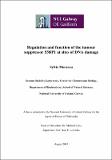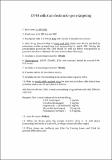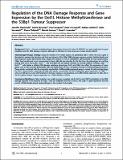| dc.description.abstract | Cancer is the major cause of death for people in middle age. It results from cell
transformation into malignant cells and propagates with normal controls. This process is
induced by mutations occurring in DNA through the action of external or internal DNA
damaging agents. To protect their genome, cells have evolved mechanisms to respond
appropriately to the DNA lesion induced. A signaling cascade is activated, implicating
detection of the lesions by "sensor" proteins, amplification of the signal by "mediator"
and "transducer" proteins and diversification of this signal by "effector" proteins
involved in various pathways including cell cycle arrest, DNA repair, apoptosis or
senescence.
53BP1, first identified as a p53 binding partner, is a mediator of the DNA damage
response (DDR). It functions in cell cycle checkpoints and DNA repair, promoting nonhomologous end-joining (NHEJ) and restraining homologous recombination (HR).
Upon DNA damage, 53BP1 proteins relocalize rapidly to DNA double strand breaks
(DSBs). It has been shown that this recruitment is dependent on its Tandem Tudor
domain recognition and binding to methylated histones. However, some controversy
exist in the literature regarding the exact nature of the methylated histone required. It
has been defined to be either histone H3 dimethylated on its lysine 79, H3K79me2, or
histone H4 dimethylated on its lysine 40, H4K20me2.
Firstly, we investigated the role of H3K79me2 in the recruitment of 53BP1 to DSBs.
We generated a DT40 chicken cell line deficient for H3K79me2 and monitored 53BP1
foci formation upon DNA damage. Our data indicated that H3K79me2 is not required
for the general recruitment of 53BP1 to DSBs. Technical limitations restrained our
investigation on the role of H4K20me2 in 53BP1 relocalisation. However, parallel
literature researches lead us to examine the relationship between 53BP1 and p53 upon
DNA damage. Our results show that in the absence of p53, the efficiency of 53BP1
localisation to DSBs is reduced while the recruitment of BRCA1, a HR factor, is
enhanced. We also found that HR is more efficient in absence of p53. Altogether, our
data suggest that p53 acts early in the DDR as a "mediator" protein regulating the
balance between HR and NHEJ through the recruitment of 53BP1 and BRCA1. | en_US |




